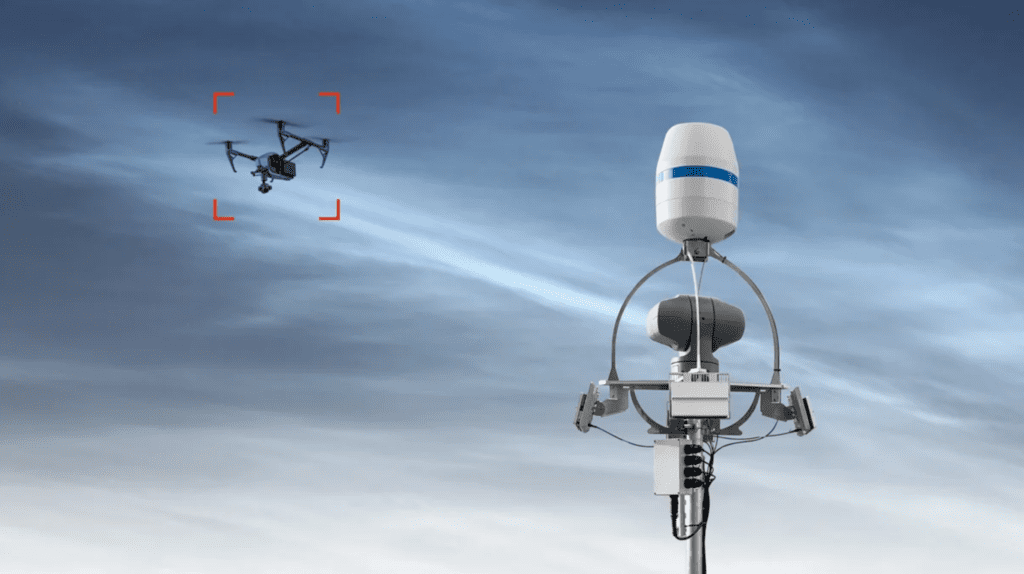가장 인기 있는 안티 드론 장비
업계 배경
System C생략
탐지 시스템
RF 감지 시스템
레이더 감지 시스템
전자광학 추적 시스템(EOTS)
카운터 시스템
소프트 킬 장비
드론 재머
드론 스푸퍼
하드킬 장비
레이저 장비
업계 배경
인공지능, 통신 기술, 항공 공학 기술의 급속한 발전으로 드론의 활용 범위는 점점 더 넓어지고 있습니다. 상업적 용도에서 군사 작전에 이르기까지 드론은 현대 사회에서 없어서는 안 될 필수 요소가 되었습니다.

그림 1에서 볼 수 있듯이 전 세계 드론 시장은 지속적인 상승세를 보이고 있습니다. 이는 또한 점점 더 많은 드론의 잠재적 위험에 직면하게 될 것이라는 의미이기도 합니다. 드론의 관리를 강화하기 위해 미국, 중국, 일본, 유럽연합은 잇달아 드론 RID 관리 규정을 도입했습니다. 그러나 단순한 RID 모드는 허가받지 않은 드론 비행 활동에는 실패할 수 있습니다. 따라서 보다 포괄적인 안티드론 솔루션이 필요합니다. 레이더와 광전자, 소프트 킬 시스템과 하드 킬 시스템 등이 이에 해당합니다.
시스템 구성
드론 방지 시스템에 대한 설명을 시작하기 전에 두 가지 질문이 있습니다:
- 드론은 어떻게 찾나요?
- 드론을 공격하는 방법?

이것이 바로 핵심 문제입니다.안티 Uas 시스템을 구축합니다.
첫 번째 질문인 "드론을 찾는 방법"부터 시작하겠습니다. 지금 당장 가장 먼저 떠오르는 것은 아마도 레이더일 것입니다. 실제로 레이더는 드론 탐지에서 중요한 역할을 합니다. 드론 탐지에는 위상 배열 레이더가 주로 사용됩니다. 레이더 외에도 RF 감지 장치와 광전자 추적 장치가 있습니다. 이러한 각 장치는 독립적으로 실행되거나 서로 보완하기 위해 함께 사용될 수 있으므로 재정 예산에 따라 이러한 장치 중 어떤 장치를 구입할지 결정할 수 있습니다. 모든 것을 구입하는 것이 최선의 선택이며 자금이 제한되어 있다면 RF 감지 시스템을 선택하는 것이 최선의 선택이 될 것입니다.

드론을 탐지하는 방법에 대한 문제를 해결한 다음에는 "드론을 공격하는 방법"에 대해 이야기해 보겠습니다. 먼저 드론을 공격하는 방법은 소프트 킬과 하드 킬로 나뉘는데, 일상에서 가장 많이 사용되는 것은 드론 재밍 장치와 GNSS 스푸핑 장비와 같은 소프트 킬 장치입니다. 하드 킬은 일반적으로 레이저와 같은 물리적 파괴를 의미합니다.
소프트 킬을 선택하는 사람들이 늘어나는 이유는 무엇인가요?
전자파 간섭 소프트 킬 장비의 사용이 더 간단하기 때문에 가격이 저렴하고 부피와 무게가 상대적으로 더 적절합니다.
그러나 소프트 킬링 방법에는 몇 가지 결함이 있어 강력한 전파 방해 방지 기능을 갖춘 특수 무인 항공기에는 유효하지 않을 수 있습니다. 이것이 바로 하드 킬이 필요한 이유입니다. 그러나 소프트 킬은 기본적으로 현재 대부분의 무인 항공기를 처리 할 수 있으므로 소프트 킬 장비는 안티 드론에서 매우 중요한 역할을합니다. 소프트 킬 장비를 무시하지 마세요. 현재 시장의 소프트 킬 장비는 모든 UAV 통신 주파수 대역을 커버할 수 있습니다.
레이저는 가장 강력한 살상 수단인 드론의 존재를 무시해서는 안 됩니다. 총 없이 드론을 쏘는 것이 더 낫지 않겠냐고 생각할 수도 있습니다. 사람이 조종하는 빠른 비행 드론으로 목표물을 맞추는 것은 매우 어렵다는 것을 알아야 합니다. 레이저 장비는 탐지 데이터를 통해 목표물 조준 동작을 완료하도록 유도합니다. 장비. 레이저의 단점은 비싸고 복잡하며 범위가 제한적이라는 점입니다.
위의 장치들을 한데 모아 완벽한 안티 무인 항공기 시스템을 구성하여 무인 항공기를 찾아서 대응하는 작업을 실현할 수 있습니다. 이것이 앞서 말씀드린 두 가지 질문에 대한 답입니다. 이 두 가지 측면에서 구체적인 장비 내용을 소개하겠습니다. 이 두 가지 측면에서 구체적인 장비 내용을 소개하겠습니다. 하나는 탐지 시스템이고 다른 하나는 카운터 시스템입니다.
탐지 시스템
RF 감지
무엇 스펙트럼 탐지:
스펙트럼 감지 기술은 주파수 영역에서 신호의 분포와 특성을 분석하여 무선 신호를 식별, 측정 및 위치 파악하는 기술입니다. UAV 스펙트럼 감지 장비에서 스펙트럼 감지 기술은 주로 공중 무선 신호를 실시간으로 모니터링하고 분석하여 신호의 주파수, 대역폭 및 전력과 같은 주요 매개 변수를 얻는 데 사용됩니다.
a장점 RF 탐지:
- 수동 감지, 능동적으로 신호를 전송하지 않음
- 전파는 넓은 지역을 커버할 수 있을 만큼 충분히 멀리 이동합니다.
- UAV의 고정밀 포지셔닝을 실현할 수 있습니다.
- 무선 감지 비용은 레이더, 광전자, 음향 및 기타 UAV 감지 기술에 비해 매우 저렴합니다.
장애장점 RF 탐지:
- 신호 암호화는 해독하기 어렵습니다.
- 전자기 간섭에 취약함
- FPV를 찾기가 어렵습니다.
레이더 감지
무엇 위상 배열 레이더:
위상 배열 레이더는 위상 제어 전자식 스캔 어레이 레이더입니다. 빠르고 정밀한 빔 변환 기능 덕분에 레이더는 1분 이내에 전체 공간의 스캔을 완료할 수 있습니다. 소위 위상 배열 레이더는 다수의 동일한 방사 요소로 구성된 레이더 어레이입니다. 각 방사 요소
는 웨이브 컨트롤러와 위상 시프터에 의해 위상과 진폭이 독립적으로 제어되어 정확하고 예측 가능한 방사 패턴과 빔 방향을 얻을 수 있습니다.
안티-Uas 레이더는 주로 X 및 Ku 대역을 사용하여 "저속 저속" 표적을 탐지하고 이중 편파 완전 일관성, 지능형 레이더 데이터 처리, 다중 소스 데이터 융합 및 기타 기술을 합성하여 "저속 및 저속 표적" + "저고도 미세 기상" 표적의 전천후, 활성, 다중 표적 및 정밀 탐지를 실현할 수 있습니다.
a장점 rADAR 탐지:
- 빠른 스캔 속도, 유연하고 제어 가능한 빔
- 긴 감지 범위
- 표적 용량이 크고 영공에서 수백 개의 표적을 동시에 모니터링하고 추적할 수 있습니다.
- 강력한 간섭 방지 기능
- 복잡한 대상 환경에 대한 강력한 적응성
- 높은 신뢰성
장애장점 rADAR 탐지:
- 높은 비용
- 장비가 복잡합니다.
- 가까운 거리에 사각지대가 있습니다.
- 빔 스캐닝 범위가 제한되어 있습니다.
전자광학 추적 시스템(EOTS)
전자광학 추적 시스템이란 무엇인가요?
광전자 식별 및 추적 장비는 가시광선과 적외선 이미징 기술을 결합하고 광학 시스템을 통해 대상의 광학 정보를 수집하고 처리 및 분석을 위해 전기 신호로 변환하여 대상의 신속하고 정확한 식별 및 추적을 실현합니다.
a장점 전자 광학 추적 시스템:
- 고화질 카메라, 고정밀
- 강력한 물체 인식 능력
- 실시간 이미지 전송
- 자동 타겟 추적
장애장점 전자 광학 추적 시스템:
- 환경의 영향을 받음
- 기술적 정교함
- 강력한 하드웨어 종속성
- 광학 카메라는 더 비쌉니다.
카운터 시스템
탐지 시스템을 통해 드론을 탐지한 후에는 드론을 방어하는 방법의 문제를 해결해야 합니다. 드론을 방어하는 방법은 일반적으로 소프트 킬과 하드 킬의 두 가지 주요 범주로 나뉩니다. 소프트 킬은 주로 전자 기술을 통해 이루어지며 하드 킬은 물리적 파괴를 사용합니다. 현재 가장 일반적인 것은 소프트 킬 기술인데, 이는 비용 대비 성능이 우수하고 구현하기 어렵지 않기 때문입니다. 소프트 킬 기술은 전자기파 기술을 적용하여 동일한 주파수 신호를 전송하여 UAV의 원격 제어 신호와 영상 전송 신호를 방해하는 기술입니다. 이 기술은 드론 재밍 장치에 처음 사용 된 후 드론 스푸핑 장치로 생성되었으며, 시장에는 드론 재밍 장치가 넘쳐나고 있으며 이에 대해 먼저 논의 해 보겠습니다. 그런 다음 드론 디코이 디바이스에 대해 살펴보겠습니다.
드론 재머
드론 재머란 무엇인가요?
고주파 전자파 기술을 사용하여 무인 항공기 통신 대역과 동일한 주파수 대역에서 전자파를 전송하여 무인 항공기가 리모컨의 명령을 수신하는 것을 방해하여 무인 항공기가 리모컨의 명령 및 비디오 신호를 정상적으로 파싱할 수 없어 제어권을 잃고 사전 설정된 절차에 따라 귀환 또는 착륙합니다.
일반적으로 재머는 구조에 따라 고정형 재머, 배낭형 재머, 휴대용 재머 등 여러 가지 범주로 분류합니다. 아래에는 이러한 각 유형에 해당하는 몇 가지 이미지가 나열되어 있습니다.
특정 사용 사례에 따라 어떤 구조의 방해 전파 차단기를 선택할지 결정해야 합니다. (적합한 재머를 선택하는 방법은 무엇인가요?)
a장점 드론 재머:
- 가격이 저렴합니다. 높은 가성비
- 여러 통신 주파수 대역을 커버할 수 있습니다.
- 여러 대상을 동시에 재밍하기
장애장점 드론 재머:
- 간섭 거리가 제한됩니다.
- 높은 장비 성능
- 드론에 직접적인 손상을 입히지 않으며, 드론이 출발 지점으로 돌아가거나 제자리에 안전하게 착륙할 수 있을 뿐입니다.
드론 스푸퍼
드론 스푸퍼란 무엇인가요?
잘못된 GPS 신호를 보내면 드론이 위치 정보를 정확하게 얻을 수 없어 위치 오프셋이 발생하거나 내비게이션 기능이 손실될 수 있습니다.
시장은 주로 고정식 스푸핑 장비와 휴대용 스푸핑 장비로 나뉩니다. GNSS 스푸핑 장비의 구조에는 큰 차이가 없으며, 우리가 주목해야 할 것은 여러 위성 위치 확인 시스템의 신호를 커버한다는 것입니다. 우리는 4대 글로벌 포지셔닝 시스템의 주류를 알고 있습니다: GPS, 베이더우, 갈릴레오, 글로나스. 일반적으로 네 가지 시스템 모두의 신호가 필요합니다. 일반적인 드론에는 최소 두 개의 GNSS 로케이터가 있기 때문에, 예를 들어 DJI의 많은 드론에는 세 개 또는 네 개의 로케이터가 있을 수 있습니다. 따라서 완벽을 기하기 위해서는 스푸핑 장치가 4개의 주요 GNSS를 모두 커버하는 것이 가장 좋습니다.
a장점 드론 스푸퍼:
- 낮은 디바이스 전력 소비
- 드론의 비행에 직접적인 영향을 미칠 수 있으며, 심지어 드론 추락의 원인이 될 수도 있습니다.
- 재머보다 커버리지가 더 넓습니다.
장애장점 드론 스푸퍼:
- 재머보다 가격이 상대적으로 비쌉니다.
- GNSS 기능이 없는 드론에 대응할 수 없음
- 해당 지역의 모든 장치의 GNSS 기능에 영향을 미칩니다.


